欧洲文化入门期末论文
欧洲传统文化论文
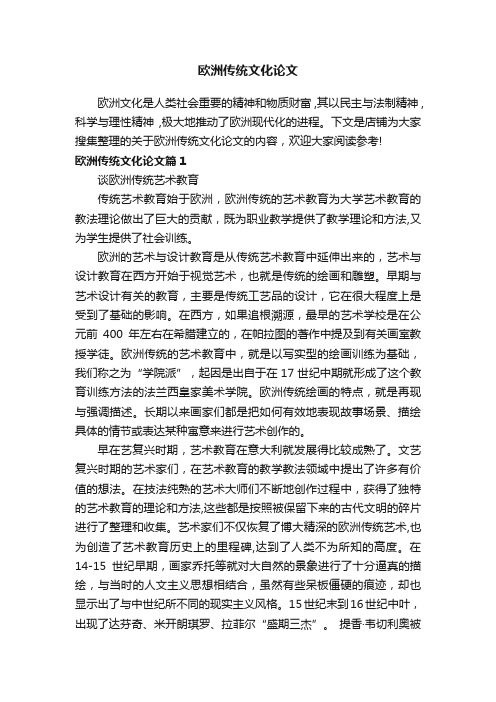
欧洲传统文化论文欧洲文化是人类社会重要的精神和物质财富 ,其以民主与法制精神 ,科学与理性精神,极大地推动了欧洲现代化的进程。
下文是店铺为大家搜集整理的关于欧洲传统文化论文的内容,欢迎大家阅读参考!欧洲传统文化论文篇1谈欧洲传统艺术教育传统艺术教育始于欧洲,欧洲传统的艺术教育为大学艺术教育的教法理论做出了巨大的贡献,既为职业教学提供了教学理论和方法,又为学生提供了社会训练。
欧洲的艺术与设计教育是从传统艺术教育中延伸出来的,艺术与设计教育在西方开始于视觉艺术,也就是传统的绘画和雕塑。
早期与艺术设计有关的教育,主要是传统工艺品的设计,它在很大程度上是受到了基础的影响。
在西方,如果追根溯源,最早的艺术学校是在公元前400年左右在希腊建立的,在帕拉图的著作中提及到有关画室教授学徒。
欧洲传统的艺术教育中,就是以写实型的绘画训练为基础,我们称之为“学院派”,起因是出自于在17世纪中期就形成了这个教育训练方法的法兰西皇家美术学院。
欧洲传统绘画的特点,就是再现与强调描述。
长期以来画家们都是把如何有效地表现故事场景、描绘具体的情节或表达某种寓意来进行艺术创作的。
早在艺复兴时期,艺术教育在意大利就发展得比较成熟了。
文艺复兴时期的艺术家们,在艺术教育的教学教法领域中提出了许多有价值的想法。
在技法纯熟的艺术大师们不断地创作过程中,获得了独特的艺术教育的理论和方法,这些都是按照被保留下来的古代文明的碎片进行了整理和收集。
艺术家们不仅恢复了博大精深的欧洲传统艺术,也为创造了艺术教育历史上的里程碑,达到了人类不为所知的高度。
在14-15世纪早期,画家乔托等就对大自然的景象进行了十分逼真的描绘,与当时的人文主义思想相结合,虽然有些呆板僵硬的痕迹,却也显示出了与中世纪所不同的现实主义风格。
15世纪末到16世纪中叶,出现了达芬奇、米开朗琪罗、拉菲尔“盛期三杰”。
提香·韦切利奥被誉为西方油画之父,继承和发展了威尼斯派的绘画艺术,提香对于欧洲后来的绘画艺术有着很大的影响。
欧洲文化的论文(3)
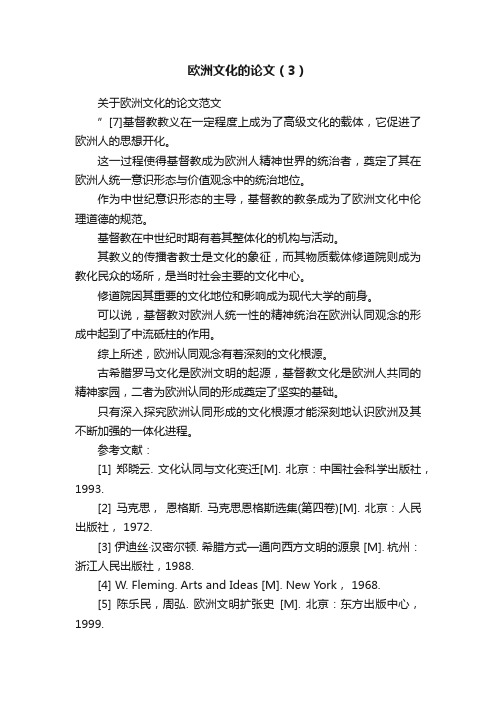
欧洲文化的论文(3)关于欧洲文化的论文范文”[7]基督教教义在一定程度上成为了高级文化的载体,它促进了欧洲人的思想开化。
这一过程使得基督教成为欧洲人精神世界的统治者,奠定了其在欧洲人统一意识形态与价值观念中的统治地位。
作为中世纪意识形态的主导,基督教的教条成为了欧洲文化中伦理道德的规范。
基督教在中世纪时期有着其整体化的机构与活动。
其教义的传播者教士是文化的象征,而其物质载体修道院则成为教化民众的场所,是当时社会主要的文化中心。
修道院因其重要的文化地位和影响成为现代大学的前身。
可以说,基督教对欧洲人统一性的精神统治在欧洲认同观念的形成中起到了中流砥柱的作用。
综上所述,欧洲认同观念有着深刻的文化根源。
古希腊罗马文化是欧洲文明的起源,基督教文化是欧洲人共同的精神家园,二者为欧洲认同的形成奠定了坚实的基础。
只有深入探究欧洲认同形成的文化根源才能深刻地认识欧洲及其不断加强的一体化进程。
参考文献:[1] 郑晓云. 文化认同与文化变迁[M]. 北京:中国社会科学出版社,1993.[2] 马克思,恩格斯. 马克思恩格斯选集(第四卷)[M]. 北京:人民出版社, 1972.[3] 伊迪丝·汉密尔顿. 希腊方式—通向西方文明的源泉 [M]. 杭州:浙江人民出版社,1988.[4] W. Fleming. Arts and Ideas [M]. New York, 1968.[5] 陈乐民,周弘. 欧洲文明扩张史[M]. 北京:东方出版中心,1999.[6] Anthony Pagden. The Idea of Europe [M]. Woodrow Wilson Center Press and Cambridge University Press. U.K. 2002.[7] 惠一鸣. 欧洲联盟发展史(上). 北京:中国社会科学出版社,2003年第1版.。
欧洲文化概况论文 苏格拉底
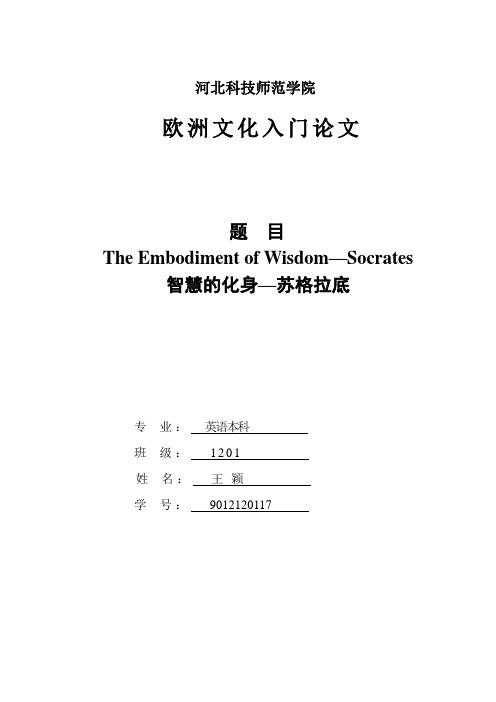
Socrates's philosophy is an influential part of philosophy, because of his great personality. After he dead, his thoughts has significant impact on successive philosophers, even common people can perceive truth to conduct their life.
Using all his life to show what happiness is, what beauty is, how we can spend our life. We know that Socrates's appearance is as famous as his philosophy, but it is not because he is handsome, conversely, he is ugly. However, he persists into giving speeches on the square. Socrates is intended to tell people that we should experience the reality, and settle present problems. If you are sad because of your appearance, you are really foolish. If you think others pay attention to and laugh at you when you are walking on the street, you are wrong, for they only care themselves. If you are an ugly duckling, the only thing you can do is to believe you are also beautiful, rather than think how to be a white swan. There is no happiness, when there is no reality,
欧洲文化入门论文
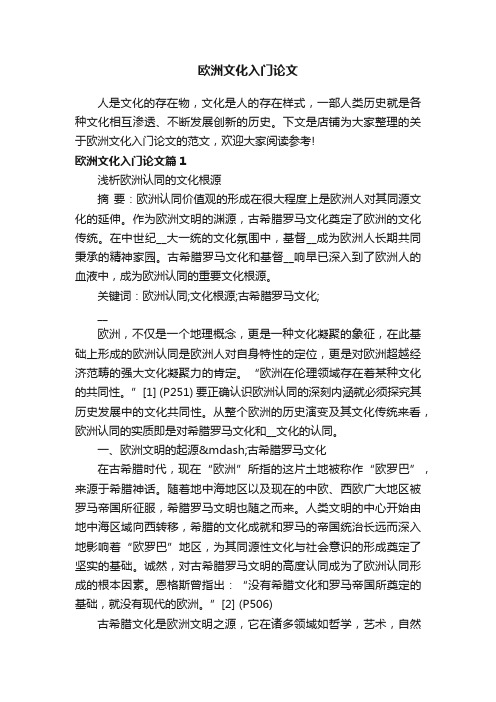
欧洲文化入门论文人是文化的存在物,文化是人的存在样式,一部人类历史就是各种文化相互渗透、不断发展创新的历史。
下文是店铺为大家整理的关于欧洲文化入门论文的范文,欢迎大家阅读参考!欧洲文化入门论文篇1浅析欧洲认同的文化根源摘要:欧洲认同价值观的形成在很大程度上是欧洲人对其同源文化的延伸。
作为欧洲文明的渊源,古希腊罗马文化奠定了欧洲的文化传统。
在中世纪__大一统的文化氛围中,基督__成为欧洲人长期共同秉承的精神家园。
古希腊罗马文化和基督__响早已深入到了欧洲人的血液中,成为欧洲认同的重要文化根源。
关键词:欧洲认同;文化根源;古希腊罗马文化;__欧洲,不仅是一个地理概念,更是一种文化凝聚的象征,在此基础上形成的欧洲认同是欧洲人对自身特性的定位,更是对欧洲超越经济范畴的强大文化凝聚力的肯定。
“欧洲在伦理领域存在着某种文化的共同性。
”[1] (P251) 要正确认识欧洲认同的深刻内涵就必须探究其历史发展中的文化共同性。
从整个欧洲的历史演变及其文化传统来看,欧洲认同的实质即是对希腊罗马文化和__文化的认同。
一、欧洲文明的起源—古希腊罗马文化在古希腊时代,现在“欧洲”所指的这片土地被称作“欧罗巴”,来源于希腊神话。
随着地中海地区以及现在的中欧、西欧广大地区被罗马帝国所征服,希腊罗马文明也随之而来。
人类文明的中心开始由地中海区域向西转移,希腊的文化成就和罗马的帝国统治长远而深入地影响着“欧罗巴”地区,为其同源性文化与社会意识的形成奠定了坚实的基础。
诚然,对古希腊罗马文明的高度认同成为了欧洲认同形成的根本因素。
恩格斯曾指出:“没有希腊文化和罗马帝国所奠定的基础,就没有现代的欧洲。
”[2] (P506)古希腊文化是欧洲文明之源,它在诸多领域如哲学,艺术,自然科学等领域的研究成就以及其繁荣发达的城邦政治文化为欧洲创立了规范。
对真理的不懈追求和理性精神是古希腊文化的核心,也构成了欧洲文化的精神主线。
古希腊重视对各种知识进行分类研究,将哲学独立为一门科学。
欧洲文化入门
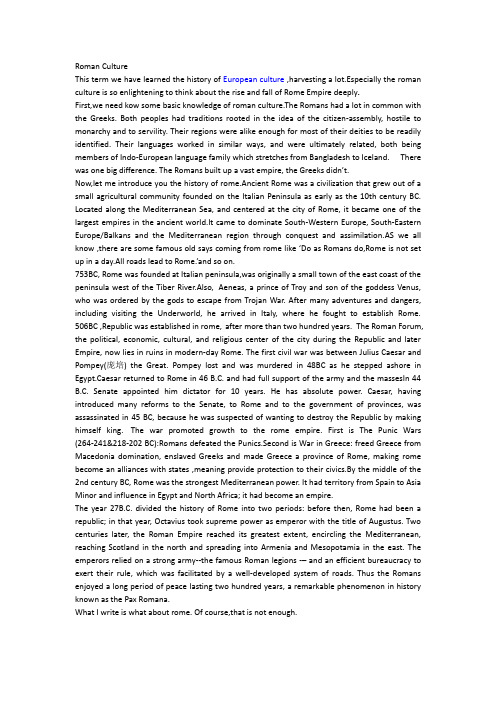
Roman CultureThis term we have learned the history of European culture,harvesting a lot.Especially the roman culture is so enlightening to think about the rise and fall of Rome Empire deeply.First,we need kow some basic knowledge of roman culture.The Romans had a lot in common with the Greeks. Both peoples had traditions rooted in the idea of the citizen-assembly, hostile to monarchy and to servility. Their regions were alike enough for most of their deities to be readily identified. Their languages worked in similar ways, and were ultimately related, both being members of Indo-European language family which stretches from Bangladesh to Iceland.There was one big difference. The Romans built up a vast empire, the Greeks didn’t.Now,let me introduce you the history of rome.Ancient Rome was a civilization that grew out of a small agricultural community founded on the Italian Peninsula as early as the 10th century BC. Located along the Mediterranean Sea, and centered at the city of Rome, it became one of the largest empires in the ancient world.It came to dominate South-Western Europe, South-Eastern Europe/Balkans and the Mediterranean region through conquest and assimilation.AS we all know ,there are some famous old says coming from rome like ‘Do as Romans do,Rome is not set up in a day.All roads lead to Rome.’and so on.753BC, Rome was founded at Italian peninsula,was originally a small town of the east coast of the peninsula west of the Tiber River.Also,Aeneas, a prince of Troy and son of the goddess Venus, who was ordered by the gods to escape from Trojan War. After many adventures and dangers, including visiting the Underworld, he arrived in Italy, where he fought to establish Rome.506BC ,Republicwas established in rome,after more than two hundred years.The Roman Forum, the political, economic, cultural, and religious center of the city during the Republic and later Empire, now lies in ruins in modern-day Rome.The first civil war was between Julius Caesar and Pompey(庞培) the Great.Pompey lost and was murdered in 48BC as he stepped ashore in Egypt.Caesar returned to Rome in 46 B.C. and had full support of the army and the massesIn 44 B.C. Senate appointed him dictator for 10 years. He has absolute power.Caesar, having introduced many reforms to the Senate, to Rome and to the government of provinces, was assassinated in 45 BC, because he was suspected of wanting to destroy the Republic by making himself king.The war promoted growth to the rome empire. First is The PunicWars (264-241&218-202 BC):Romans defeated the Punics.Second is War in Greece: freed Greece from Macedonia domination, enslaved Greeks and made Greece a province of Rome, making rome become an alliances with states ,meaning provide protection to their civics.By the middle of the 2nd century BC, Rome was the strongest Mediterranean power. It had territory from Spain to Asia Minor and influence in Egypt and North Africa; it had become an empire.The year 27B.C. divided the history of Rome into two periods: before then, Rome had been a republic; in that year, Octavius took supreme power as emperor with the title of Augustus. Two centuries later, the Roman Empire reached its greatest extent, encircling the Mediterranean, reaching Scotland in the north and spreading into Armenia and Mesopotamia in the east. The emperorsrelied on a strong army--the famous Roman legions -– and an efficient bureaucracy to exert their rule, which was facilitated by a well-developed system of roads. Thus the Romans enjoyed a long period of peace lasting two hundred years, a remarkable phenomenon in history known as the PaxRomana.What I write is what about rome. Of course,that is not enough.。
欧洲文化入门小论文
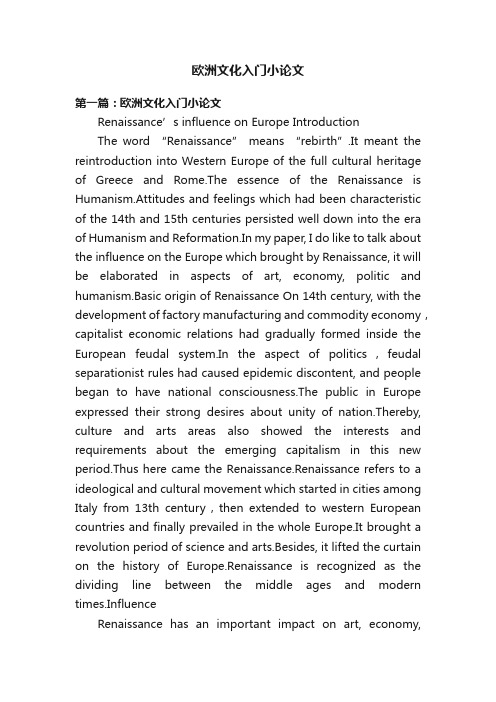
欧洲文化入门小论文第一篇:欧洲文化入门小论文Renaissance’s influence on Europe IntroductionThe word “Renaissance” means “rebirth”.It meant the reintroduction into Western Europe of the full cultural heritage of Greece and Rome.The essence of the Renaissance is Humanism.Attitudes and feelings which had been characteristic of the 14th and 15th centuries persisted well down into the era of Humanism and Reformation.In my paper, I do like to talk about the influence on the Europe which brought by Renaissance, it will be elaborated in aspects of art, economy, politic and humanism.Basic origin of Renaissance On 14th century, with the development of factory manufacturing and commodity economy,capitalist economic relations had gradually formed inside the European feudal system.In the aspect of politics,feudal separationist rules had caused epidemic discontent, and people began to have national consciousness.The public in Europe expressed their strong desires about unity of nation.Thereby, culture and arts areas also showed the interests and requirements about the emerging capitalism in this new period.Thus here came the Renaissance.Renaissance refers to a ideological and cultural movement which started in cities among Italy from 13th century,then extended to western European countries and finally prevailed in the whole Europe.It brought a revolution period of science and arts.Besides, it lifted the curtain on the history of Europe.Renaissance is recognized as the dividing line between the middle ages and modern times.InfluenceRenaissance has an important impact on art, economy,political and humanism of Europe.It is the New Culture Movement and Cultural Revolution of the bourgeoisie.Art In art, the most prosperous period of Italian Renaissance was the 16th century.It’s representative artist are Da Vinci, Michelangelo and Raphael.Renaissance brought about sense of change in all aspects of life and a favorable atmosphere for artistic innovation and experimentation.Colours of arts are very varied and graceful and artist used bright colours bravely to show that people had entered a new period of golden age.Talented artist used their opus to reflect the transition of the thought in the society.For example, Mona Lisa Smile, magnum opus from Da Vinci, it described a wife of merchant instead of noblewoman.This painting told people life can be happy even in such a dark society like that time and it also hinted the change of women’s society statuses.This portraiture was recognized as the laurel of world arts masterpiece.It conveys appreciation to beauty of women and the abundant spirit life of people.What’s more, wealth gathered in towns created demand for refinement in arts and variety in form and content.Renaissance replaced the medieval notions of painting and sculpture as crafts only to decorate churches by that of highly intellectual artistic accomplishments, with merge of art and science.For example, Villa Rotonda , Notre Dame de Paris, St Peter's and so on.Its also prevent free literary creation, but its restless curiosity, its interest in the world and its urban influences created a demand for a native literature that expressed the new life then;and its individuality with a concern for fame drove writers to do experiments to win praise from critics and support from patrons.For example, Dante’s The Divine Melody and Petrarch’s Love sonnets.The arts in Renaissance not only establish the foundation of European realism arts, but also impelpeople to pursuit better society lives with its profound spiritual connotation and exquisite artistry.The masterpieces which created in Renaissance are captivating and master-designed.They become the priceless treasures in treasure house of human.Renaissance had a great influence on development of the world’s art, it can encourage people to lead a positive life and it proposed the explore spirit.It played a essential role in the development of human beings.Economy In financial terms, Renaissance, as a mind emancipation movement to develop and expand cultural of the emerging bourgeoisie, laid an important foundation of the sprout of the early capitalism in it’s transmit.In the meantime, Renaissance accumulated original wealth for the early capitalism.Renaissance first started from Italy, and then transferred to Atlantic coast from the Mediterranean Coast by transmission.Many famous boom city like Roman, Florence, Venice and other cities appeared.Capitalist industry and commerce began to develop prosperously.What’s more, capital started to swarm into the pockets of capitalism.Renaissance provided requirements to exploitation of the new route, reformation of religious reform and the later the revolution of bourgeoisie.Political The occurrence of every important activity will affect the art aspect, the financial term, also the politic.On 14th century, Europe began to enter the modern civilization period.Industry and commerce developed prosperously and capitalism appeared in many cities.Emerging bourgeoisie began to enter the political stage.The needed new ideologies to speak in defense of interests of politic and economy which they pursuit.The needed new academics and culture to support what they want to do.Thus, a totally new Modern spirit came into being.Renaissance was the new culture movement whichobjected to religious authority and feudalism.Then, how did the Renaissance affect the political system in Europe? First, commerce replaced the Catholic as the unifying force in Europe.Second, because of the bourgeoisie’s struggle for political control, the Holy Roman Empire and the Roman Catholic Church declined.Third, rulers of the Italian city-states thus empowered for expansion abroad.Fourth, on account of their wish for peace and order after civil wars, Monarchies was consolidated in France, England and Spain.Humanism The last part I want to talk is the humanism effects brought to Europe by Renaissance.As an individual, one should get important social position by his ability to gain knowledge.With this view, architects begin to design as people-based, painters and sculptors paid much attention to individuals.People tried to comprehend physiology and psychology structure of human beings and thinking process.Renaissance and its accompanying humanist philosophy were the most important reform in the history of human beings.The centre of this power was a knowledge group which named humanist.They pursuit the concept of humanism and their basic theory was realism.Their purposes were reclaiming peaceful and happy lives for people.Humanism studied the value of people, the spirit of people, the life of people and the felicity of people.Then, how did the Renaissance affect the development of humanism? Renaissance made philosophy emphasized the dignity and worth of the individual, it was the originated in the study of classical culture.By the study of grammar, rhetoric, history, poetry and ethics of humanities, people developed hisphysically, morally and intellectually.Humanism brought a new art form by its totally new understanding about thecivilization and the world.It connects people and space.ConclusionRenaissance was the shed between middle ages and modern times.It was the consensus premise for bourgeois revolution.It assisted Europe getting rid of the constraints from feudal religious and it was the prelude for Europe to expand to the world.Reference 徐新编著《西方文化史》北京大学出版社叶胜年著《西方文化史鉴》上海外国语教育学院第二篇:欧洲文化入门《巴黎圣母院》读后感读完了《巴黎圣母院》,文中的丑与美,善与恶,在我的脑海里留下了挥之不去的印象。
欧洲文化论文(中西文化对比)
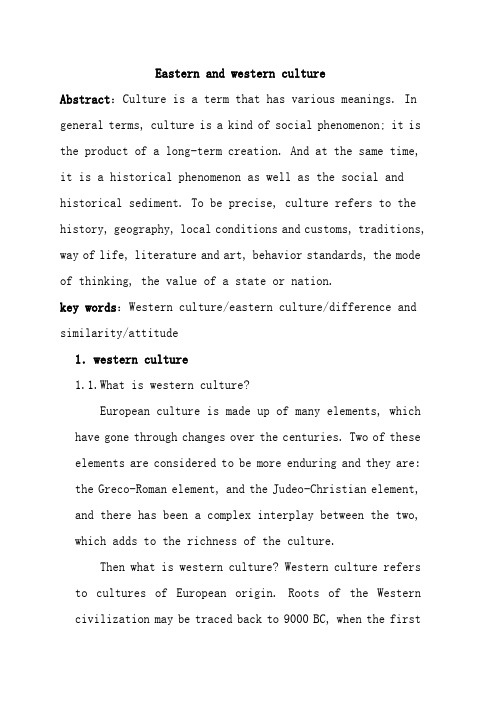
Eastern and western cultureAbstract:Culture is a term that has various meanings. In general terms, culture is a kind of social phenomenon; it is the product of a long-term creation. And at the same time, it is a historical phenomenon as well as the social and historical sediment. To be precise, culture refers to the history, geography, local conditions and customs, traditions, way of life, literature and art, behavior standards, the mode of thinking, the value of a state or nation.key words:Western culture/eastern culture/difference and similarity/attitude1.western culture1.1.What is western culture?European culture is made up of many elements, which have gone through changes over the centuries. Two of these elements are considered to be more enduring and they are: the Greco-Roman element, and the Judeo-Christian element, and there has been a complex interplay between the two, which adds to the richness of the culture.Then what is western culture?Western culture refers to cultures of European origin. Roots of the Western civilization may be traced back to 9000 BC, when the firstgreat cultures grew out of agricultural cores in South-West Asia, China, Pakistan, Mexico, and Peru. The Westernmost of this Old World's agricultural cores, the area around the headwaters of the Euphrates, Tigris, and Jordan Rivers in South-West Asia, spread outwards across Europe. Western culture in its strictly European geographical range began with the Greeks, was enlarged and strengthened by the Romans, reformed and modernized by the fifteenth-century Renaissance and Reformation, and globalize by successive European empires that spread the European ways of life and education between the sixteenth and twentieth centuries. European Culture developed with a complex range of philosophy, medieval scholasticism and mysticism, Christian and secular humanism. Rational thinking developed through a long age of change and formation with the experiments of enlightenment, naturalism, romanticism, science, democracy, and socialism. With its global connection, European culture grew with an all-inclusive urge to adopt, adapt, and ultimately influence other trends of culture.2. Eastern cultureWhen it comes to Chinese culture, we will first thinkabout Confucianism. And we will call Confucius to our mind. Now, let me give you some other examples that related to Chinese culture.2.1. Study of Chinese Folklore in ChinaThe Book of Songs, the earliest known Chinese collection of poetry, contains 160 folk songs in addition to courtly songs and hymns. It is believed that Confucius did encourage his followers to study the songs contained in the Shi Jing, helping to secure the Shi Jing’s place among the Five Classics. After Confucian ideas became further entrenched in Chinese culture, Confucius’ end orsement led many scholars to study the lyrics of the Shi Jing and interpret them as political allegories and commentaries.2.2. Numbers in Chinese cultureIn Chinese culture, certain numbers are believed by some to be auspicious (吉利) or inauspicious (不利) based on the Chinese word that the number name sounds similar to. However some Chinese people regard these beliefs to be superstitions. Since the pronunciation and the vocabulary may be different in different Chinese dialects, the rules are generally not applicable for all cases. Because of the supposed auspiciousness of certain numbers, some peoplewill often choose, attempt to obtain, or pay large sums for numbers that are considered to be lucky for their phone numbers, street addresses, residence floor, driver's license number, vehicle license plate number, bank account number, etc.Lucky numbers are based on Chinese words that sound similar to other Chinese words. The numbers 6, 8, and 9are believed to have auspicious meanings because their names sound similar to words that have positive meanings.2.3. Table mannersChinese table manners are the traditional styles that are used for eating in the region of China. In most dishes in Chinese cuisine(烹饪), food is cooked in bite-sized pieces and easy to grab and eat. Therefore, chopsticks are used at the table instead of forks and knives. Eating is a dominant aspect of the Chinese culture. In China, eating out is one of the most accepted ways to treat guests. Similar to Westerners drinking in a bar with friends, eating together in China is a way to socialize and deepen friendship.There are many traditions that govern table manners in China such as the correct treatment of guests and how touse chopsticks correctly. Although each Chinese household has its own set of table manners and rules, the foundational traditions used to welcome guests are the same.3. The difference between western culture and eastern culture.As we know, there are so many differences between east and west culture. And I can not list all of their different aspects. For your better understanding, I will focus on the differences of some common customs of China and America.3.1.It is no doubt that using chopstick is a traditional custom for Chinese people. But people in America prefer to forks and knives. This difference is based on different food they like .Americans choose to eat beefsteak, bread, and salad, while Chinese people choose noodles, pancakes and rice. What’s more, the custom of drinking tea in China and drinking coffee in America are standing out particularly.3.2.Greeting and PartingIn China, when people meet acquaintances or friends, we always say, “Have you eaten yet?” What are you going to do?” but In English, people often employ the following expressions to greet each other “Goodmorning/evening/afternoon. “Fine day, isn’t it? ” “How is everything going?” etc3.3. Compliments and ResponseFor example, if a hostess is complimented for her cooking skill, how she will response in west and china?A Chinese hostess will apologize for giving you “Nothing”. She will say“I just made some dishes casually and they are not very tasty.”But an western hostess is likely to say, “Oh, I am so glad that you liked it. I cook it especially for you.”3.4. Thanks and ResponsesIn China,“Thank you” is not frequently used between intimate friends and family members because it may imply a certain distance between the addresser and the addressee. But “Thank you” is widely used in English to show gratitude in such cases as being invited, helped, given a gift, etc. So much examples, I hope you could have a better understanding of Chinese and European culture.4. The attitude we should take toward different culture. There are so many difference between two culture background. For our Chinese, there is no denying that the European culture is worthy to be learned by us. But during thisprocess, how will we treat this civilization and use it? It’s really necessary for us to think over.Someone says that the western culture is superior. It is one of the reasons they learn about it. But on the contrary, many people strongly disagree with this, they believe our own culture is the best, and we should keep it without any change. In my opinion, in order to develop our culture, we should do like the following.4.1. remove the dross while keeping the essence.First, the advantage such as education system, we should learn from other country. But the disadvantage like our own festival, we should keep it going from generation to generation. Only by doing this can our culture developed in the right way.4.2 Borrow the foreign cultures while using our brains.In the second place, we should borrow the foreign cultures while using our brains. Have you realized that you are the sacrificial lamb instead of flaunting the individuality when you are going for the western-cultured skirt and the junk food? Today, our traditional culture which should be carried forward is destroyed seriously by the culture abroad. If one day Confucius possibly revives,don’t you feel that it is so dismal to point at the classical roofs of the skyscrapers beside the Chang’an Street and tell him, “This is our Chinese civilization”? Looking at our Chinese architecture, except the so-called classical architecture “culture heritage” es tablished by the culture protection association, most of the architectures are of “modern style”. Maybe the reason is that they are the product of imitating the style of western architecture. They have no origins as well as belongings. So we can just cal t hem “modern”. Can we say that we learn from the west well? Many parents bring their children to the KFC without minding waiting for a long time because there are so many people queuing up and waiting for there turn. This kind of improper education, which fawning on the foreign things, leads to the distruction of our cultural root which is actually insecure before. We does not imitate well, while gradually lost our tradition. The most fundamental or important things are often been ignored. We have our Confucius(the founder of our dominant culture), Zhuangzi(the most intelligent philosopher), Qin Shi Huang(the most influential statesman), Xuanzang(the most serious adoptionist and scholar)… There is no lack ofsages while people in this generation are lacking mind or ideas.Someone says that pro-human life culture is Western culture. And the extent to which a nation embraces Western culture is the extent to which it is free, prosperous, modern and peaceful. That is supportive of human life. One need only look at life expectancies around the world to see that whether this is true.The civilization of our own was delivered from generation to generation for thousands of years. But today, we can see obviously that citizens of our nation are becoming more and more fa wning on foreign things. It’s so easy to find a shirt with English words. It’s so prevailing to wear jeans. We like going into the European-styled restaurant to enjoy the western food. We say “Bye-bye” instead of “zaijian”. What’s more, our traditional festivals like the Spring Festival are desolated. We celebrate the Valentine’s Day every February instead of the Chinese Valentine’s Day according to the lunar calendar every June.参考文献:。
欧洲文化导论论文
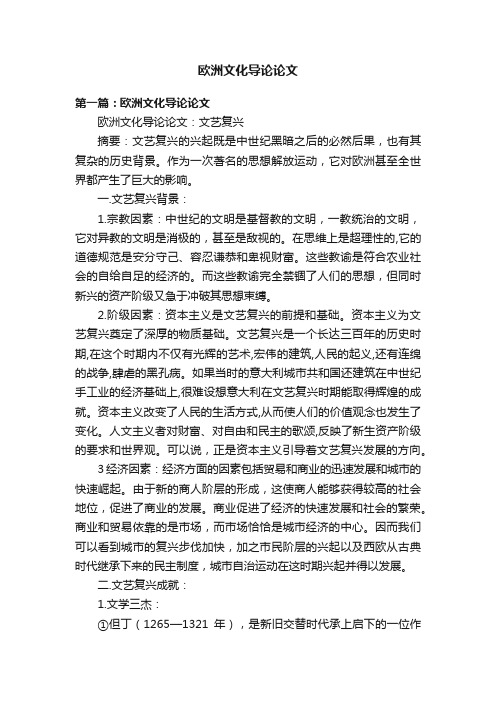
欧洲文化导论论文第一篇:欧洲文化导论论文欧洲文化导论论文:文艺复兴摘要:文艺复兴的兴起既是中世纪黑暗之后的必然后果,也有其复杂的历史背景。
作为一次著名的思想解放运动,它对欧洲甚至全世界都产生了巨大的影响。
一.文艺复兴背景:1.宗教因素:中世纪的文明是基督教的文明,一教统治的文明,它对异教的文明是消极的,甚至是敌视的。
在思维上是超理性的,它的道德规范是安分守己、容忍谦恭和卑视财富。
这些教谕是符合农业社会的自给自足的经济的。
而这些教谕完全禁锢了人们的思想,但同时新兴的资产阶级又急于冲破其思想束缚。
2.阶级因素:资本主义是文艺复兴的前提和基础。
资本主义为文艺复兴奠定了深厚的物质基础。
文艺复兴是一个长达三百年的历史时期,在这个时期内不仅有光辉的艺术,宏伟的建筑,人民的起义,还有连绵的战争,肆虐的黑孔病。
如果当时的意大利城市共和国还建筑在中世纪手工业的经济基础上,很难设想意大利在文艺复兴时期能取得辉煌的成就。
资本主义改变了人民的生活方式,从而使人们的价值观念也发生了变化。
人文主义者对财富、对自由和民主的歌颂,反映了新生资产阶级的要求和世界观。
可以说,正是资本主义引导着文艺复兴发展的方向。
3经济因素:经济方面的因素包括贸易和商业的迅速发展和城市的快速崛起。
由于新的商人阶层的形成,这使商人能够获得较高的社会地位,促进了商业的发展。
商业促进了经济的快速发展和社会的繁荣。
商业和贸易依靠的是市场,而市场恰恰是城市经济的中心。
因而我们可以看到城市的复兴步伐加快,加之市民阶层的兴起以及西欧从古典时代继承下来的民主制度,城市自治运动在这时期兴起并得以发展。
二.文艺复兴成就:1.文学三杰:①但丁(1265—1321年),是新旧交替时代承上启下的一位作家,马克思、恩格斯称他为“中世纪的最后一位诗人,同时又是新时代的最初一位诗人。
”其代表作《神曲》主要描写作者在梦中由罗马诗人维吉尔和他的恋人碧雅特丽丝引导他遍游地狱、炼狱、天堂三界的故事。
西方文化精要期末论文

这学期我选了西方文化精要这门课程。
我之所以选这门课程,因为我自己对西方文化很感兴趣,通过这学期的学习,我已经基本对西方文化有些认识了。
下面我就谈谈自己的理解和看法。
在课堂上我了解到了西方文化来自于两希文明,即古希腊和古希伯来文明。
因此我就重点谈谈古希腊神话古希腊神话。
作为西方文化的源头之一,正如马克思所说,希腊神话是它的土壤和武库。
古希腊的戏剧、建筑、绘画、雕塑等都从古希腊神话中汲取养料。
所以可以说,古希腊神话是西方文化的重要源头。
古希腊神话是西方文化百用而不厌其烦的素材,这已是人所共知的。
就像老师开始上课时就给我们说了不少古希腊神话。
西方文化从古希腊神话中汲取的两钟重要的精神血液即人本和理性,这两种精神恰是整个西方近代文化的两个主要精神。
关于神话与古希腊神话,马克思在《<政治经济学>导言》中说,神话是“通过人的幻想,用一种不自觉的艺术方式加工过的自然和社会形式”是“用想象和借助想象以征服自然力、支配自然力,把自然力加以形象化”。
所以神话是人类对自然与自我以及自然与自我关系的探索。
神话应该是氏族的、部落的、民族的,乃至某一人群团体原初的自然观、世界观真实的理性的表现。
神话反映人的思想和理念,而且“神话作为一个民族足迹的最早记录,因为较少受到传统文化的熏染,或当代文明的压抑,它直接的表现了人性中接近底层或本质的东西。
”古希腊神话作为有丰富体系的神话,当然也表现了古希腊人性中最本质的精神。
我们现在所知的所有古希腊神话的故事都来自《荷马史诗》和赫西俄德的《神谱》和《工作与时日》。
《荷马史诗》包括《伊利亚特》和两部。
《伊利亚特》记述的是古代希腊人与特洛伊人交战攻打伊利亚特的经过。
《奥塞德》描写了希腊军返航途中的种种遭遇,荷马之后的赫西俄德写了《神谱》和《工作与时日》希腊诸神的渊源,历史的发端。
公元前六世纪到公元前三世纪间,希腊三为悲剧大师埃斯库罗斯、索福克勒斯、欧里匹得斯的经典著作也极大的丰富了希腊神话的内容。
欧洲文化入门论文
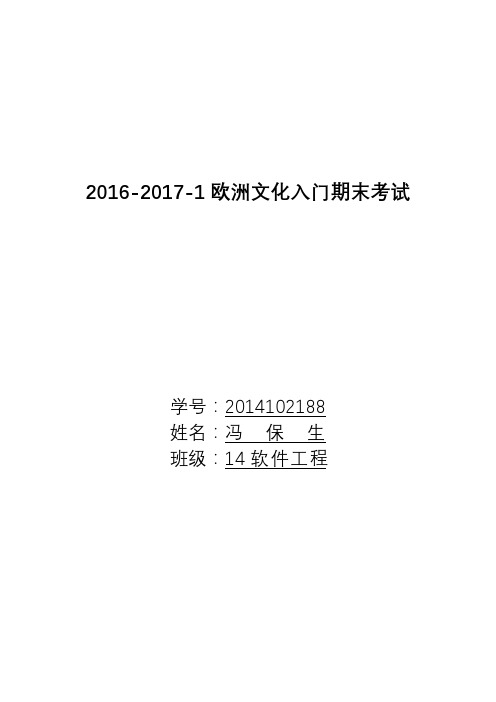
2016-2017-1欧洲文化入门期末考试学号:**********姓名:冯**班级:14软件工程从欧洲最早的两大文明:米诺斯文明及迈锡尼文明算起,欧洲的文明史已经超过四千年了,欧洲文明的发源地是在爱琴海及古希腊地区,这里气候宜人,交通方便,为文明的产生提供了先决条件。
欧洲有着悠久的文明发展史。
公元前4000~前2500年在南欧和西欧曾广泛分布有巨石文化,随后位于欧洲东南部的爱琴海地区勃兴为世界古文明的发祥地之一,称爱琴文明,给人类留下了丰富的文化遗产。
公元前6世纪,古罗马国家兴起,逐渐发展成一个囊括半个欧洲(大不列颠群岛至多瑙河口一线以南)及北非、西亚在内的庞大帝国,而意大利所在的意大利半岛一直是其政治和经济的核心区域。
纪元初年,欧洲人口约3200万,其中半数以上分布于南欧,而东欧、北欧及不列颠群岛合计尚不足1/10。
公元3世纪后,罗马帝国渐趋衰弱,原先居住在北欧的日耳曼人及居住在东欧的斯拉夫人相继大量入侵,这一历史进程所伴随的人口大迁移和经济、文化上的广泛交流,大大促进了欧洲的全面开发,14世纪中叶全洲人口达到8100万,南欧的比重降至1/3,其他地区尤其是东欧均明显上升。
15~16世纪,在南欧和西欧的一些国家中,资本主义开始萌芽,通过地理大发现和对海外殖民地的掠夺,西班牙、葡萄牙、荷兰、法国和英国相继发展成为具有世界影响的强国,在随后的资产阶级革命和产业革命中,西欧进一步确立了在欧洲经济、文化中的领先地位。
19世纪中叶,北欧、中欧和东欧诸国也走上了资本主义发展道路,南欧国家发展则相对缓慢。
1900年欧洲人口为4.15亿,南欧的比重已不足1/4。
由于资本主义的迅速发展,19世纪欧洲的经济、文化水平在世界上已遥遥领先,几个欧洲列强的殖民地遍布各大洲,几千万欧洲人移居海外,对世界人文地理和经济地理产生了极大的影响。
20世纪的前半期,欧洲先后成为两次世界大战的主要策源地。
由于战争的破坏,以及资本主义政治、经济发展不平衡规律的作用,欧洲在世界上的地位相对下降,其人口占世界的比重由1900年的25%下降到1950年的20%,工业生产所占比重亦由65%降至45%。
欧洲文化入门期末论文

欧洲文化入门期末论文Renaissance in ItalyThe word Renaissance is a French word meaning new birth, a name given to the movement in Europe that inspired men to abandon the restraints of the Middle Ages and to develop modern interests, enthusiasm and ideals. Its most noted feature was the Revival of Learning, an awakening of mind and a thirst after the new knowledge.Key words: Italian Renaissance background humanism New Literature Renaissance Art1.BackgroundIn the 12th century, a rediscovery of Greek and Roman literature occurred across Europe that eventually led to the development of the humanist movement in the 14th century. In addition to emphasizing Greek and Latin scholarship, humanists believed that each individual had significance within society. The growth of an interest in humanism led to the changes in the arts and sciences that form common conceptions of the Renaissance.The 14th century through the 16th century was a period of economic flux in Europe, the most extensive changes took place in Italy. After the death of Frederick II in 1250, emperors lost power in Italy and throughout Europe, none of Frederick's successors equaled him. Power fell instead into the hands of various popes; after the Great Schism (1378–1415; see Schism, Great), when three popes held power simultaneously, control returned to secular rulers.During the Renaissance small Italian republics developed into despotisms as the centers of power moved from the landed estates to the cities. Europe itself slowly developed into groupsof self-sufficient compartments. At the height of the Renaissance there were five major city-states in Italy: the combined state of Naples and Sicily, the Papal State, Florence, Milan, and Venice. Italy's economic growth is best exemplified in the development of strong banks, most notably the Medici bank of Florence. England, France, and Spain also began to develop economically based class systems.2.HumanismHumanism is the keynote of Renaissance.Renaissance humanism was an activity of cultural and educational reform engaged by scholars, writers, and civic leaders who are today known as Renaissance humanists. It developed during the fourteenth and the beginning of the fifteenth centuries, and was a response to the challenge of medieval scholastic education, emphasizing practical, pre-professional and pre-scientific studies. The main centers of humanism were Florence and Naples.2.1 The main content of humanism2.1.1Man is the measure of all things, man-centered culture .It emphasize the power, value and dignity of the human beings andholding that human beings are glorious creatures. And the lines of Shakespeare’s Hamlet is the best summary of the core of Renaissance thought---the greatness of man.2,1,2Emphasize the dignity of human beings and the importance of the present life.It emphasize secular happiness and individualism against the medieval ideas of asceticism, shifting man’s interest from Christianity to humanity, from religion to philosophy, from beauty and greatness of God to the beauty of human body in allits joys and pains.2.1.3Believe human beings were glorious creatures and man has the right to pursue personal happiness, knowledge and wealth.It applies Aristotle’s theory that humanist literature mainly use realistic style and take literature as the mirror or miniature of the society. Therefore these Italians, and many others, helped to make Italy the center of the Renaissance movement in Europe. The movement changed the medieval Western Europe into a modern one.3.New literature3.1Three outstanding heroes of Florence literature3.1.1Giovanni BoccaccioFrench-born Italian poet and writer whose classic work, the Decameron (1351-1353), is a collection of 100 tales told by seven young ladies and three younger gentlemen. In 1348, a terrible plague attacked Florence. Every day, even every hour, large numbers of human remains were carried to the outskirts of the town . From March to July, the death toll amounted to more than 100000, Florence City, became a cemetery ,which is full of wild land, bones. no one could bear to look at it . In order to record human disaster, Boccaccio took this plague as a background, wrote one of the Italy's most famous short story collection" Decameron ". At that time," Decameron " was referred to as the" music", which is known as a companion with Dante’s " Divine Comedy”.3.1.2Francesco PetrarchItalian poet, scholar, and humanist who is famous for Canzoniers, a collection of love lyrics songs written in his Italian dialect. It expresses the author’s true love to his girl friend Lauraand the view of love and happiness. He praised the beauty of the girl in the reality and considered young men and women have the right to enjoy the love. He lapsed into extremely sad when Laura died of illness .A painful emotion can easily seen in his poem. Such feelings have got rid of the abstract and symbolic significance of medieval literature .We look upon him as the father of modern poetry because in his sonnets for Laura he showed himself to be a great humanist writer keenlyaware of mortal and earthly values and he ignored medieval courtly conventions and defined true emotions.3.1.3Dante AlighieriHe was commonly known as Dante, a major Italian poet of the Middle Age, the founder of Modern Italian---one of the pioneering figures in The European Renaissance. His Divine Comedy, originally called Comedy and later called Divine by Boccaccio, is considered the greatest literary work composed in the Italian language and a masterpiece of world literature. It is a narrative poem in terza rima containing 14 233 lines organized into 100 cantos approximately 142 lines each and can be calleda spiritual travel book.4.Renaissance art4.1The two peaks of Renaissance artOne is the radical break with medieval methods of representing the visible world occurred in Italy during the 2nd half of the 13th century the other is the decided break with the medieval pictorial tradition until the 2nd decade of the 15th century.4.2Distinct features of Renaissance artThe first is the breakaway from the domination of the church.The second is the changed themes of painting from purely celestial realm to an appreciation of all aspects of nature and man.The third is the studies of the ruins of Roman and Greek temples andthe revival of the principles of ancient civilization into their works.The fourth is the introduction of scientific theories of anatomy and perspective in artistic works.4.3Early Renaissance Artists4.3.1GiottoHe was the forerunner of the Renaissance who was said to have determined the course of painting in Europe. He led the way of restoring dignity to human figures. He also worked towards a more realistic depiction of space.His famous work Flight into Egypt is a painting based on the story in the Bible with Maria riding on a donkey that is ready to face the hardship ahead. She looked firm and resolute while her husband Joseph looked hesitant and sorrowful. His another painting, Betrayal of Judas is also very famous.4.3.2Filippo BrunelleschiFlorentine architect, one of the initiators of the Italian Renaissance. His revival of classical forms and his championing of an architecture based on mathematics, proportion, and perspective make him a key artistic figure in the transition from the Middle Ages to the modern era. In his designing of the churches he showed a systematic use of perspective. He also introduced motif that was widely imitated during the Renaissance.In 1420 he began to build the dome for the cathedral in Florence and it became the most original construction in the building ofdomes in the world history of architecture.Other early Renaissance artists, including Donatello, Giorgione also made great contribution to the art.4.4High Renaissance Artists4.4.1Leonardo da VinciLeonardo da Vinci was known not only as a masterful painter but as an architect, sculptor, engineer, and scientist. His pursuit of knowledge was relentless and his discoveries left lasting changes in the fields of art and science. With his sophisticated skills and love for learning, Leonardo was the quintessential Renaissance man. In painting he stressed the expression of emotional states. As a painter Leonardo is best known for The Last Supper and Mona Lisa . His other works, The Virgin of the Rocks, Vitruvian Man, Four Caricatures, are also favored by people.4.4.2Michelangelo BuonarrotiMichelangelo's extraordinary accomplishments in painting, sculpture, and architecture made him one of the outstanding figures in Renaissance art. He is known for painting the ceiling of the Sistine Chapel and rendering the human form in a wide variety of positions and with great emotional expression in painting and sculpture, and creating several of the most important works of the Italian Renaissance, such as the sculpture of David and Moses, the marble statue of Dying Slave and so on.Other high Renaissance artists, like Raphael, Titian also left many worldfamous works to us.The Renaissance resulted in numerous investigations of natural events, in a widespread study of art and literature and in a broadening of outlook to a degree never before known.Economic and intellectual changes during the Renaissance both helped to speed up Western social and cultural development and hence prepared the necessary conditions for rapid progress in political, social and ideological areas of the modern Age.。
欧洲文化论文 The Sources of European Civilization
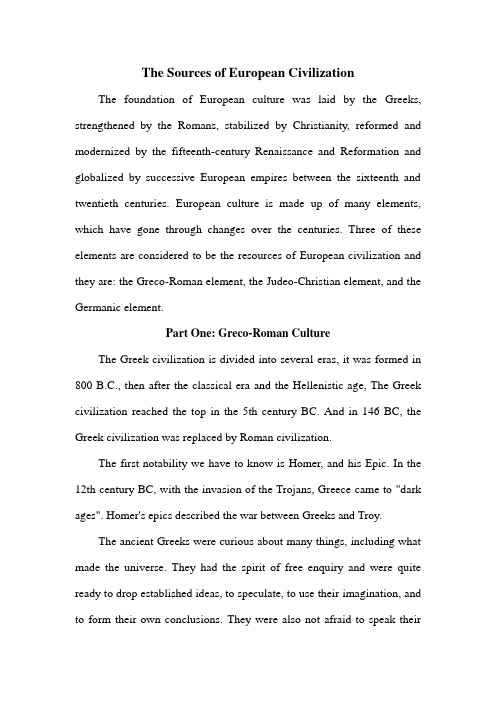
The Sources of European CivilizationThe foundation of European culture was laid by the Greeks, strengthened by the Romans, stabilized by Christianity, reformed and modernized by the fifteenth-century Renaissance and Reformation and globalized by successive European empires between the sixteenth and twentieth centuries. European culture is made up of many elements, which have gone through changes over the centuries. Three of these elements are considered to be the resources of European civilization and they are: the Greco-Roman element, the Judeo-Christian element, and the Germanic element.Part One: Greco-Roman CultureThe Greek civilization is divided into several eras, it was formed in 800 B.C., then after the classical era and the Hellenistic age, The Greek civilization reached the top in the 5th century BC. And in 146 BC, the Greek civilization was replaced by Roman civilization.The first notability we have to know is Homer, and his Epic. In the 12th century BC, with the invasion of the Trojans, Greece came to "dark ages". Homer's epics described the war between Greeks and Troy.The ancient Greeks were curious about many things, including what made the universe. They had the spirit of free enquiry and were quite ready to drop established ideas, to speculate, to use their imagination, and to form their own conclusions. They were also not afraid to speak theirminds. And also, due to the plays the Greeks performed at religious festivals early in their remote past, a powerful drama developed in the 5th century B.C.. The ancient Greece had created many philosophers and playwrights. Mainly represented by philosopher Socrates, Plato and Aristotle. Socrates pulled the importance of the free debate forward. Plato's goal was to achieve a society which can both maintains noble, and be accepted by the poor. Aristotle sought for the order for every aspect of nature and human social. The famous playwrights were Aeschylus with his Agamemnon, Sophocles with his Oedipus the King, and Euripides with his Trojan Women.Also, historical writing started early in Greece. Here we have Herodotus, who is often called “Father of History”, wrote about the war between Greeks and Persians, and Thucydides.The Greeks set an example by the bold effort they made to understand the world by the use of human reason. The body of ideas the Greek philosophers expressed, and the variety of questions the raised about the nature of the world and of human thought, knowledge and conduct, have had an abiding interest for later generations. In literature, too, they have exerted an influence which can still be felt today. Countless writers have quoted, adapted, borrowed from and otherwise use Homer’s epics, Sappho’s lyrics, the tragedies of Aeschylus and Sophocles and Euripides, Aristophanes’s comedies, Plato’s Dialogues, etc. so thattheir themes, characters, episodes, their particularly striking passages, phrases, even single words and their derivative are familiar to educated people the world over, a cherished legacy from that splendid period of human history.Then let’s come to Roman Culture. The most important contribution the Romans made to European culture was the foundation of Roman Law. Also, in architecture and art Romans made outstanding contributions, like the Colosseum and the Pantheon.Part Two: Judeo-Christian CultureAmong all the religions by which people seek to worship, Christianity is by far the most influential in the West. Every phase of man’s life is touched by this religion, so much so that it has become part and parcel of Western culture. Judaism and Christianity are closely related. In fact, it was the Jewish tradition which gave birth to Christianity. Both originated in Palestine—the hub of migration and trade routes, which led to exchange of ideas over wide areas.The Old Testament recorded the history of the Jews. Jews were once called Hebrews,strayed in Middle East Desert in about 3800 BC. In about 1300 BC, they gradually settled down in Canaan, and formed a small kingdom.Christianity and Judaism have close relationship. The core of the Christian is Jesus Christ, its doctrine is: one, Jesus Christ is the son ofgod, god sent him to men, suffer torments with humans and eventually save mankind. Second, the Christ is the only son of god , anyone who believe in Christ finally get eternal life.The major Christian classic is the bible. The "bible" is consist of the new testament and the old testament. The Old Testament has 39 parts writing about the things happened during 1000-B.C. to 100A.D. the most important parts including genesis, the exodus, "Levi remember", "the number of people remember", "deuteronomy". The New Testament came after the rise of Christian, with a total of 27 volumes. The first four volumes talks about the legend of Jesus' words and deeds, and the legend of the Jesus' apostles.Part Three: Germanic CultureIn the latter part of the fourth century the Huns swept into Europe from central Asia, robbing and killing as they came along, and large numbers of the half civilized Germanic tribes such as the Visigoths, the Franks, the Angles and Saxons, and the V andals fled their homelands in northern Europe and were pushed to cross the Danube river into the territory of the Roman Empire. In A.D. 476 a Germanic general killed the last Roman emperor and took control of the government. While the Eastern Roman Empire continued, the power of ancient Rome was gone. In its place mushroomed a great many Germanic kingdoms, which in a few hundred years were to grew into the nations known as England,France, Spain, Italy, and Germany. This is a period in which classical, Hebrew and Gothic heritages merged. And it is this fusion and blending of different ideas and practices that paved the way for the development of what is present-day European culture.Christianity played a very important role in Europe political life of the feudal society; it became the spiritual pillar of the feudal system. Christian world rejected alien and militant control (o ne of the most famous was the Crusades). Especially a few times to invade Palestine. Although it ended in failure, but promoted the cultural exchange between east and west, and prepared for the formation of the monarchy.In the academy and science, Charlemagne and his Carolingian Renaissance, Alfred the Great and his academic centre, St. Thomas Aquinas’ Scholasticism and Roger Bacon, all did great contribution to the preserve and development of the culture.In literary, there was a long Epic. The Anglo-Saxon's epic "the Europe of Woolf" is the most complete one spread until now, and the song of Roland is the most famous French epic. There were also great poets, Dante and Chaucer. And the famous Italian poet Dante's "divine comedy" is the landmark in the world literature history, expressing the upcoming Renaissance humanistic ideas. Geoffrey Chaucer is called the first short story writer in English literature history and the first modern poet, his most famous work is the Canterbury tales.The architecture and art is mainly the Romanesque and gothic, they are the extension of classical art.To sum up, European Civilization has inherited a lot from the Classical Civilization, including ancient Greek philosophy sense, ancient Roman laws, Latin language, and most significantly, Christianity.And those three cultures we have talked about are the main resources of European culture; they are all of vital importance in the development of European culture.。
欧洲文化概况论文
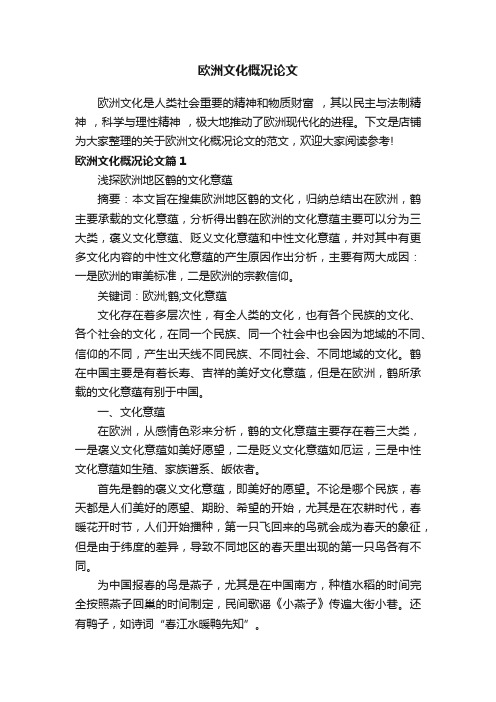
欧洲文化概况论文欧洲文化是人类社会重要的精神和物质财富,其以民主与法制精神,科学与理性精神,极大地推动了欧洲现代化的进程。
下文是店铺为大家整理的关于欧洲文化概况论文的范文,欢迎大家阅读参考!欧洲文化概况论文篇1浅探欧洲地区鹤的文化意蕴摘要:本文旨在搜集欧洲地区鹤的文化,归纳总结出在欧洲,鹤主要承载的文化意蕴,分析得出鹤在欧洲的文化意蕴主要可以分为三大类,褒义文化意蕴、贬义文化意蕴和中性文化意蕴,并对其中有更多文化内容的中性文化意蕴的产生原因作出分析,主要有两大成因:一是欧洲的审美标准,二是欧洲的宗教信仰。
关键词:欧洲;鹤;文化意蕴文化存在着多层次性,有全人类的文化,也有各个民族的文化、各个社会的文化,在同一个民族、同一个社会中也会因为地域的不同、信仰的不同,产生出天线不同民族、不同社会、不同地域的文化。
鹤在中国主要是有着长寿、吉祥的美好文化意蕴,但是在欧洲,鹤所承载的文化意蕴有别于中国。
一、文化意蕴在欧洲,从感情色彩来分析,鹤的文化意蕴主要存在着三大类,一是褒义文化意蕴如美好愿望,二是贬义文化意蕴如厄运,三是中性文化意蕴如生殖、家族谱系、皈依者。
首先是鹤的褒义文化意蕴,即美好的愿望。
不论是哪个民族,春天都是人们美好的愿望、期盼、希望的开始,尤其是在农耕时代,春暖花开时节,人们开始播种,第一只飞回来的鸟就会成为春天的象征,但是由于纬度的差异,导致不同地区的春天里出现的第一只鸟各有不同。
为中国报春的鸟是燕子,尤其是在中国南方,种植水稻的时间完全按照燕子回巢的时间制定,民间歌谣《小燕子》传遍大街小巷。
还有鸭子,如诗词“春江水暖鸭先知”。
欧洲的保加利亚地区的春天也是鸟类迁徙后回巢的时间,其中鹤扮演着核心角色:当第一只鹤出现,意味着春天真得到来了!因此在保加利亚的传说中,鹤是春天的象征。
鹤带来的春天,让人们意识到已经到了播种的季节,也是对新的一年的希望,因此鹤就责无旁贷的承载起人们对新的一年的美好愿望。
其次是鹤的贬义文化意蕴,即厄运。
欧洲文化入门
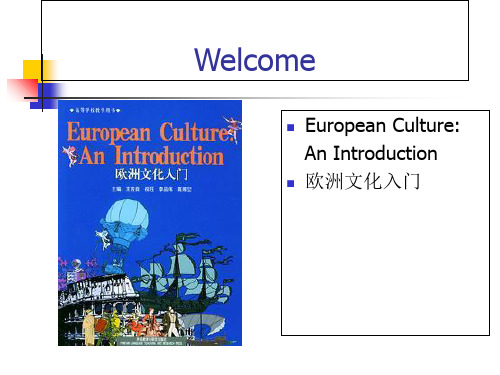
Greece and Troy
Achilles 阿喀琉斯/阿基里斯
Matching
Gold apple
Deathful weakness
Trojan horse Bane
Achilles heel Intruding destructive element
Matching (key)
Iliad 《伊利亚特》 Odyssey 《奥德赛》
Today we see Iliad and the Odyssey
incorporated into the course of almost every high school in America.
Epic
Definition:
An epic is a long narrative poem of great scale and grandiose style about the heroes who are usually warriors or even demigods.
Greece and Troy
1. Historical context (background)
War between Greece and Troy in about 1,200 B. C. Greek culture in the 5th century B. C. Civil war between Athens and Sparta. Rule of Alexander in the 4th century B. C. In 146 B. C. the Romans conquered Greece.
4. Lyric (抒情诗)
Definition: A lyric is a poem that expresses strong feeling.
欧洲文化的论文

河北大学工商学院添些学校《xxx》结课论文题目:欧洲文化之哥特式建筑姓名:黄文泽性别:男专业:xxx班级:xxx学号:xxx欧洲文化之哥特式建筑欧洲文化博大精深历史悠久,无论是其人文艺术方面的发展还是其自然科学的严谨都吸引了广大的研究者和历史文化爱好者,经过本学期老师对欧州文化的讲解,我对本来就很感兴趣的欧洲建筑有了更深的了解和认识,下面我从其起源、建筑特点以及对现代建筑的影响简述下我眼中的欧洲建筑的代表——哥特式建筑。
哥特式建筑是中世纪下半叶起源于法国13——15世纪流行于欧洲的一种建筑风格。
主要见于天主教堂也影响到世俗建筑。
哥特式建筑以其超高的技术和艺术成就,在建筑史上占有重要是地位。
其特点主要是尖塔高耸,尖形拱门,大窗户及绘有圣经故事的花窗玻璃.营造出轻盈修长的飞天的感觉.以及新的框架结构以增加支撑顶部的力量.使整个建筑以直线线条,宏伟的外观和教堂内空阔的空间, 再结合镶着彩色玻璃的长窗,使教堂里产生一种浓厚的宗教气氛.教堂的平面仍是基本的拉丁十字型,但是其西端门的两侧增加一对高塔。
哥特式建筑结构也十分多样,主要有尖肋拱顶,飞扶壁,花窗玻璃等,下面就各国建筑代表为例来介绍哥特式结构在建筑上的体现。
意大利的哥特式建筑于十二世纪由国外传入,主要影响于北部地区.意大利没有真正接受哥特式建筑的结构体系和造型原型,只是把它当做是一种装饰风格,所以在意大利很难找到纯粹的哥特式建筑.威尼斯的世俗建筑有很多的杰作,圣马可广场上的总督宫被认为是中世纪的世俗建筑中最美丽的作品之一,成为广场的标志.城市里一般建有许多高塔,总体轮廓线很美.德国最早的哥特式教堂之一的科隆主教堂于1248年兴工,由建造过亚眠主教堂的法国人设计,有法国盛行的哥特式建筑的风格.德国的教堂很早就形成了自己的形制和风格,如德国的马尔堡的圣伊莉莎白教堂的建筑结构体现了德国教堂建筑的最早特点:屋顶平缓,陡坡屋面罩在拱顶上,高度相等的教堂中厅和侧厅,教堂内部采光是依靠端体墙上高窄普通的窗户,全然去除尖顶、高侧窗、飞扶壁等等之类的样式,可谓一大创新。
欧洲文化入门
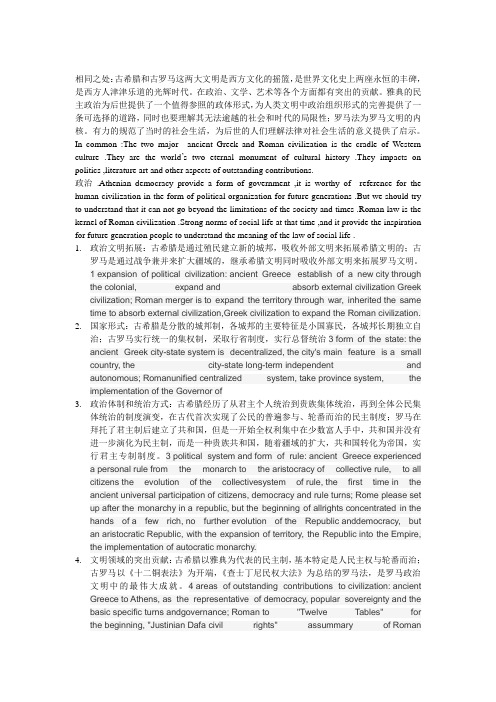
相同之处:古希腊和古罗马这两大文明是西方文化的摇篮,是世界文化史上两座永恒的丰碑,是西方人津津乐道的光辉时代。
在政治、文学、艺术等各个方面都有突出的贡献。
雅典的民主政治为后世提供了一个值得参照的政体形式,为人类文明中政治组织形式的完善提供了一条可选择的道路,同时也要理解其无法逾越的社会和时代的局限性;罗马法为罗马文明的内核。
有力的规范了当时的社会生活,为后世的人们理解法律对社会生活的意义提供了启示。
In common :The two major ancient Greek and Roman civilization is the cradle of Western culture .They are the world’s two eternal monument of cultural history .They impacts on politics ,literature art and other aspects of outstanding contributions.政治.Athenian democracy provide a form of government ,it is worthy of reference for the human civilization in the form of political organization for future generations .But we should try to understand that it can not go beyond the limitations of the society and times .Roman law is the kernel of Roman civilization .Strong norms of social life at that time ,and it provide the inspiration for future generation people to understand the meaning of the law of social life .1.政治文明拓展:古希腊是通过殖民建立新的城邦,吸收外部文明来拓展希腊文明的;古罗马是通过战争兼并来扩大疆域的,继承希腊文明同时吸收外部文明来拓展罗马文明。
欧洲文化入门论文范文参考
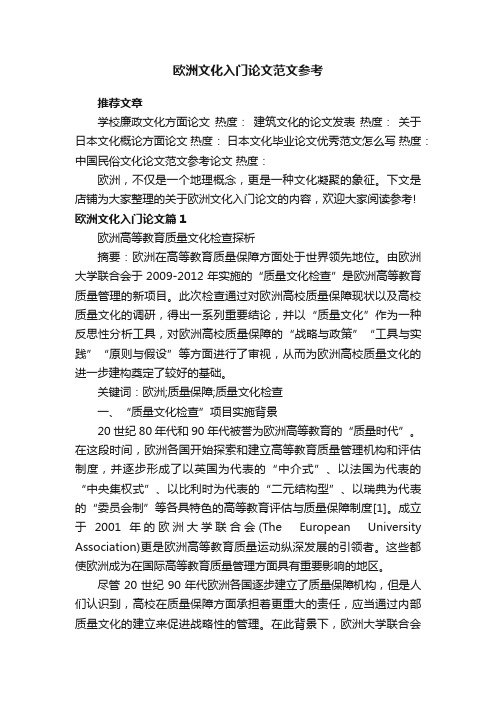
欧洲文化入门论文范文参考推荐文章学校廉政文化方面论文热度:建筑文化的论文发表热度:关于日本文化概论方面论文热度:日本文化毕业论文优秀范文怎么写热度:中国民俗文化论文范文参考论文热度:欧洲,不仅是一个地理概念,更是一种文化凝聚的象征。
下文是店铺为大家整理的关于欧洲文化入门论文的内容,欢迎大家阅读参考! 欧洲文化入门论文篇1欧洲高等教育质量文化检查探析摘要:欧洲在高等教育质量保障方面处于世界领先地位。
由欧洲大学联合会于2009-2012年实施的“质量文化检查”是欧洲高等教育质量管理的新项目。
此次检查通过对欧洲高校质量保障现状以及高校质量文化的调研,得出一系列重要结论,并以“质量文化”作为一种反思性分析工具,对欧洲高校质量保障的“战略与政策”“工具与实践”“原则与假设”等方面进行了审视,从而为欧洲高校质量文化的进一步建构奠定了较好的基础。
关键词:欧洲;质量保障;质量文化检查一、“质量文化检查”项目实施背景20世纪80年代和90年代被誉为欧洲高等教育的“质量时代”。
在这段时间,欧洲各国开始探索和建立高等教育质量管理机构和评估制度,并逐步形成了以英国为代表的“中介式”、以法国为代表的“中央集权式”、以比利时为代表的“二元结构型”、以瑞典为代表的“委员会制”等各具特色的高等教育评估与质量保障制度[1]。
成立于2001年的欧洲大学联合会(The European University Association)更是欧洲高等教育质量运动纵深发展的引领者。
这些都使欧洲成为在国际高等教育质量管理方面具有重要影响的地区。
尽管20世纪90年代欧洲各国逐步建立了质量保障机构,但是人们认识到,高校在质量保障方面承担着更重大的责任,应当通过内部质量文化的建立来促进战略性的管理。
在此背景下,欧洲大学联合会于2002-2006年实施了“质量文化项目”[2],以便在大学建立系统的质量文化保障体系,强化学校对构建内部质量文化和推进内部质量管理的必要性的认识。
欧洲文化期末论文 Rococo
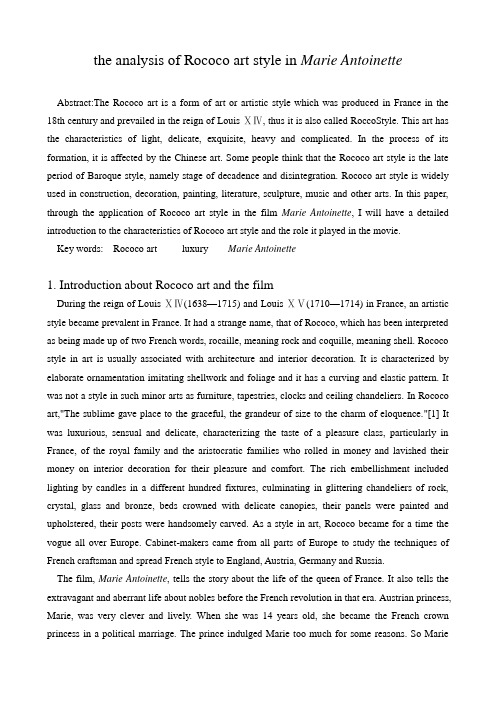
the analysis of Rococo art style in Marie AntoinetteAbstract:The Rococo art is a form of art or artistic style which was produced in France in the 18th century and prevailed in the reign of Louis ⅩⅣ, thus it is also called RoccoStyle. This art has the characteristics of light, delicate, exquisite, heavy and complicated. In the process of its formation, it is affected by the Chinese art. Some people think that the Rococo art style is the late period of Baroque style, namely stage of decadence and disintegration. Rococo art style is widely used in construction, decoration, painting, literature, sculpture, music and other arts. In this paper, through the application of Rococo art style in the film Marie Antoinette, I will have a detailed introduction to the characteristics of Rococo art style and the role it played in the movie.Key words: Rococo art luxury Marie Antoinette1. Introduction about Rococo art and the filmDuring the reign of Louis ⅩⅣ(1638—1715) and Louis ⅩⅤ(1710—1714) in France, an artistic style became prevalent in France. It had a strange name, that of Rococo, which has been interpreted as being made up of two French words, rocaille, meaning rock and coquille, meaning shell. Rococo style in art is usually associated with architecture and interior decoration. It is characterized by elaborate ornamentation imitating shellwork and foliage and it has a curving and elastic pattern. It was not a style in such minor arts as furniture, tapestries, clocks and ceiling chandeliers. In Rococo art,"The sublime gave place to the graceful, the grandeur of size to the charm of eloquence."[1] It was luxurious, sensual and delicate, characterizing the taste of a pleasure class, particularly in France, of the royal family and the aristocratic families who rolled in money and lavished their money on interior decoration for their pleasure and comfort. The rich embellishment included lighting by candles in a different hundred fixtures, culminating in glittering chandeliers of rock, crystal, glass and bronze, beds crowned with delicate canopies, their panels were painted and upholstered, their posts were handsomely carved. As a style in art, Rococo became for a time the vogue all over Europe. Cabinet-makers came from all parts of Europe to study the techniques of French craftsman and spread French style to England, Austria, Germany and Russia.The film, Marie Antoinette, tells the story about the life of the queen of France. It also tells the extravagant and aberrant life about nobles before the French revolution in that era. Austrian princess, Marie, was very clever and lively. When she was 14 years old, she became the French crown princess in a political marriage. The prince indulged Marie too much for some reasons. So Mariehad been leading an extremely extravagant life after marriage. She also had been unable to break away from inner loneliness thoroughly. This film brings us on various shock of French court and social in 18th century : inconceivable luxury, interlaced love and the French people’s final roar. 2. The effect of Rococo art in the filmIn the middle of the 18th century, people commonly use seashells, grass blade and flowers to decorate indoor items and often put into a C shape, S shape or the curve of the vortex. This style’s color is soft and insipid, such as white, light green and pink. This decorative style is slim and elegant, but slightly cumbersome and with a little affectation. In Marie Antoinette, Rococo art style can be seen everywhere. On the clothing, this grandeur palace fashion show won the 79th Oscar for Best Costume Design. This film also puts Rococo art style to an extreme in the interior decoration. In the movie, in the show of the scene at the same time, the scene is more of a service for the film. Marie Antoinette reflects the dress features in the period of Rococo art style and shows the characteristics of softness and feminine about court clothes in that era, including the grand bustle, bodice, the line in a low voice, and many flower bowknot. It highlights the female's curve and stresses characteristics of the female with an exaggerated language. There are a lot of artificial beauty aided by bodices in that era. The hair is tied up very highly with the help of supporting materials. It is an aesthetic feeling about exaggeration of feminine beauty. Both the clothes and skin look very soft.2.1 the resurgence of extravagant Rococo artMarie Antoinette is a movie about the life of Louis ⅩⅣ’s wife, Marie. And this time was also the most prosperous period in the Rococo style history. The film scene is very gorgeous and it is the most representative of Rococo art style. From construction to interior decoration and people’s dress, the scene is distributing a kind of unique and romantic sentimentalism about Rococo art style. Some comments on the Rococo art style are gaudy because its bright white and pink tonal, delicate golden and argent decorations. Rococo art style reflects social morality which are lazy, decadent and dissolute among the French upper nobility.The main features of the Rococo art style is more feminine, relaxed, noble and elegant. There are a lot using of curve in the style of Rococo art presented. The modeling of the Rococo art style are presented a C type and S type vortex line, generally are asymmetric in lieu of symmetry. The colors are bright and soft. Ivory and gold are its main color. Compared with the Baroque style, the Rococo style is more feminine and with the female's gentle and graceful. In Marie Antoinette, interior design is a kind of relaxed and lively style. In colors, blend as well as white and gray is not the style of that kind of greasy or heavy, on the contrary appearing more elegant and beautiful. While on thedecoration, it looks fine. The adornment of furniture presents a kind of heavy, complicated and luxuriant. Such as Marie’s chair, above it has a heavy and complicated vortex shape flower pattern, elegant and noble. In the film, both in construction and interior decoration, are a kind of relaxed, lively and elegant art. On the lens, this film is more delicate to the point of a mirror a painting. Any interception of a lens is just like a European palace painting about Rococo art. Because it shot on the spot in the palace of Versailles, this grand, luxurious, and with all good adjectives unspeakable its beauty famous European palace always sends out a kind of high taste of beauty. On clothing, the film also perfectly reproduce the luxurious style of 18th century in European palace, bell skirt, bodice, high heels, roll the cloud-shaped edging, fans and clothes with lotus leaf edge. Everything in this film all brings a kind of luxury visual enjoyment of beauty.2.2 Rococo art shows female sensuousnessAt the shooting of the film, the directress Sophia Coppola said, in the Marie’s small room, decorations both in tonal and utensils are completely suited to a 14-year-old girl. Looked from the saving portraits, the female officer who served her is more like her playmates. The Rococo art style is the adornment style with a female soft nature. “In Marie Antoinette, a young girl with her intelligence in politics from frustration to gradually adapt to, but resolutely and incredibly confused. She is powerful, but in its essence, is just a naive and innocent woman.”[2] In the era of the pursuit of luxury, the royal women can only study those beautiful clothes and shoes, and it has become her only hobby in empty and lonely life.The hall where Marie held the ball, has white walls with gold veins decoration. The glittering and translucent lighting which are carved skillfully are properly lightening the whole room, at the same time, they also illuminate the presence of high society women's eyes and colorful clothes. The wind of woman's soft and fruity extravagant seems flows slowly in the air. Here is not only a salon in polite society, but also a group of feminine woman's party. They have gorgeous appearance, however, they can only be hovering in these clothes and ornaments, a little depressed, ignorant and have nothing to do. In Marie’ room, the bed is so gorgeous on top of the world that making people feel dazzling. The romance of pink and in the soft bed, the gentle and innocent and romantic feelings of a woman is not consciously infected the audience. Marie while as a queen, but a gentle princess and the little girl. The hint of tenderness is slowly sent out through the kind of soft scene.2.3 The feminine mystique in magnificent sceneApplying fashion elements on a historical and political figure, in the director's lens, reduction at the same time has a big upset. In French history, Marie is a highly dissolute and shameless woman. Her extreme luxury make the country's fiscal deficit, causing a revolution in the history of theFrench. The bastille was the most famous historical events in the history of France, while Marie was guillotined was a big revolution. But in the eyes of Sophia, all this has nothing to do with politics. She doesn't talk about history. She just complete a dream about fashion, the little girl's teenage dream through borrowing a luxury figure in the history.No matter bustling Palace of Versailles or quite good manors and farmhouses, those woes in the history were ignored. Sophia doesn't copy textbooks for Marie's criticism and hate, but from a desire to interpret itself is the image of a young woman, hoping to understand her more. In Marie Antoinette, the film restores more scenes while the characters and feelings are reshaped. In the film, the setting of indoor decoration with more beautiful flowers, flowers’placement has adornment effect, at the same time, it is also a kind of pursuit and advocating the nature. In Rococo art style, the combination of lush beauty of flowers and Chinese porcelain makes the same score a point. In the film, Marie stands in the room where decorated with flowers. The dress is heavy and complicated. Fold of pink and white lace almost blend into the white walls of the background. That white printing design in the wall shows beauty of graceful and gentle and makes people feel comfortable. These scenes, in show of elegant of French and feminine of Rococo art style, at the same time, not only make the audience indulge in it, but also make Marie in the film immerse in it. Her behavior has nothing to do with politics, she is just an elegant and luxury person who lived in elegant and luxury environment. After watching the movie, a lot of the audience said that the most impressive things in addition to so many shoes and clothes are sympathy for Marie who is innocent and capricious but finally step into tragedy in joyful laughter.2.4 Luxuriant set contrast figure’s desolationSophia Coppola said: "when I was just going to make a biography movie, I began to think that how to make it out of those rules and take out of my own style. There has been a fixed pattern about biopics until today. And I just don’t want it too."[3] In Marie Antoinette,luxury scenes and the splendid Palace of Versailles, pink girl tone and white quick wagon, all these are hard to cover up the person's fate. Marie is a be doomed tragedy characters in history. Her final ending is that she was sent to guillotine in the flames of revolution.Marie originally was only a little girl, among the children of the youngest princess in Austria. In the final minute out of her homeland, she was forced to take off all clothes, even the side of the dog was not immune. The happy princess began her political career from the moment when she was sitting on the car carrying guests to the wedding, stripped and naked. “She was just a piece of political interests. She had supreme power and riches and honor, but was unable to retain her final bud silk skirt in her Austrian princess period and protect the dog which always accompanied withher.”[4] At the same time, her husband was a man who don’t know how to take care of his own wife and national affairs. The queen and her Swedish lover's story had been marked with luxuries adulterous label. Sophia Coppola restored this luxury with gorgeous images. The lifting smooth silk, full of beautiful, heavy and complicated patterns made us see court tall pillars on Marie's heavy shadows. And the film showed the court life more gorgeous, beautiful and enchanting, these all couldn't cover the sad grounding more. When she got married, in the face of her husband's wooden and incompetence, she could only lie in mellow and gorgeous bed during the night and watch the beautiful ceiling decoration, waiting in despair. And when she was having meals with her husband, the luxury of tableware couldn’t cover up two person's indifference and no longer face-to-face exchange.3. ConclusionSophia Coppola insist on her own style, and will integrate her own style into the shooting of the movie. In Marie Antoinette, colorful costumes and scenes are not only the reproduction of luxury Rococo art style in that era, but also a course about Sophia herself with her unique perspective to complete the inner pursuit and emotional exploration through using the historical figures in a historical story. Light and shadow in the film were sweet and blurred, the boulevard in front of the Palace of Versailles with natural and pure light. Marie Antoinette’s luxury Rococo art style, in the realization of a gorgeous fashion feast, at the same time, also led the audience to make a travel in the luxury, brisk and mellow Rococo art style .Bibliography[1] Will&Ariel Durant: The Age of Voltaire[M], Simon&Schuster Press, 1980.[2] 刘晶,李炜.《迷失东京》的滋味[J].电影文学,2007(17).[3] 赵柯.索菲亚•科波拉——不懂自傲的世家才女[J].新闻周刊,2004(03).[4] 奢靡无罪宠坏自己看绝代艳后的宫廷洛可可[OL]。
欧洲文化与教育论文
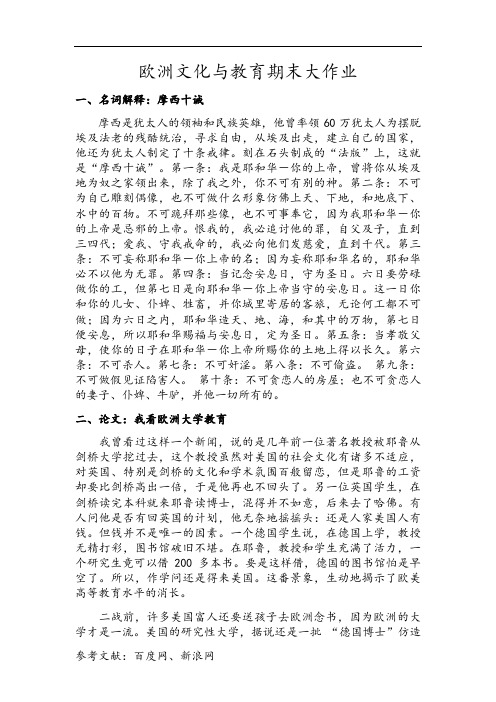
欧洲文化与教育期末大作业一、名词解释:摩西十诫摩西是犹太人的领袖和民族英雄,他曾率领60万犹太人为摆脱埃及法老的残酷统治,寻求自由,从埃及出走,建立自己的国家,他还为犹太人制定了十条戒律。
刻在石头制成的“法版”上,这就是“摩西十诫”。
第一条:我是耶和华-你的上帝,曾将你从埃及地为奴之家领出来,除了我之外,你不可有别的神。
第二条:不可为自己雕刻偶像,也不可做什么形象仿佛上天、下地,和地底下、水中的百物。
不可跪拜那些像,也不可事奉它,因为我耶和华-你的上帝是忌邪的上帝。
恨我的,我必追讨他的罪,自父及子,直到三四代;爱我、守我戒命的,我必向他们发慈爱,直到千代。
第三条:不可妄称耶和华-你上帝的名;因为妄称耶和华名的,耶和华必不以他为无罪。
第四条:当记念安息日,守为圣日。
六日要劳碌做你的工,但第七日是向耶和华-你上帝当守的安息日。
这一日你和你的儿女、仆婢、牲畜,并你城里寄居的客旅,无论何工都不可做;因为六日之内,耶和华造天、地、海,和其中的万物,第七日便安息,所以耶和华赐福与安息日,定为圣日。
第五条:当孝敬父母,使你的日子在耶和华-你上帝所赐你的土地上得以长久。
第六条:不可杀人。
第七条:不可奸淫。
第八条:不可偷盗。
第九条:不可做假见证陷害人。
第十条:不可贪恋人的房屋;也不可贪恋人的妻子、仆婢、牛驴,并他一切所有的。
二、论文:我看欧洲大学教育我曾看过这样一个新闻,说的是几年前一位著名教授被耶鲁从剑桥大学挖过去,这个教授虽然对美国的社会文化有诸多不适应,对英国、特别是剑桥的文化和学术氛围百般留恋,但是耶鲁的工资却要比剑桥高出一倍,于是他再也不回头了。
另一位英国学生,在剑桥读完本科就来耶鲁读博士,混得并不如意,后来去了哈佛。
有人问他是否有回英国的计划,他无奈地摇摇头:还是人家美国人有钱。
但钱并不是唯一的因素。
一个德国学生说,在德国上学,教授无精打彩,图书馆破旧不堪。
在耶鲁,教授和学生充满了活力,一个研究生竟可以借200多本书。
欧洲文化论文
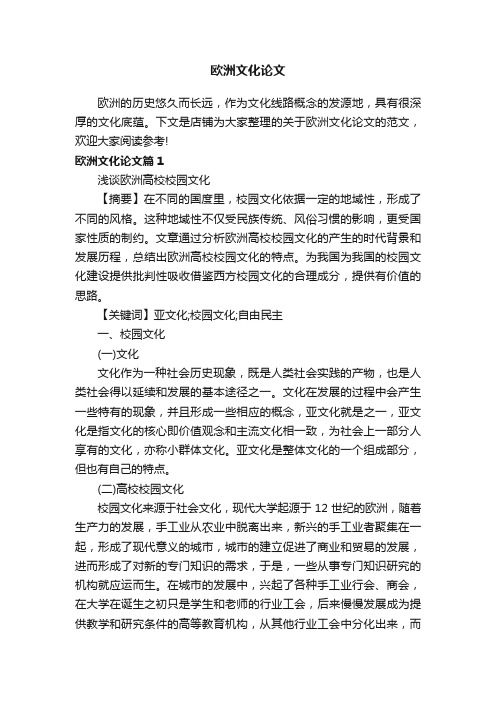
欧洲文化论文欧洲的历史悠久而长远,作为文化线路概念的发源地,具有很深厚的文化底蕴。
下文是店铺为大家整理的关于欧洲文化论文的范文,欢迎大家阅读参考!欧洲文化论文篇1浅谈欧洲高校校园文化【摘要】在不同的国度里,校园文化依据一定的地域性,形成了不同的风格。
这种地域性不仅受民族传统、风俗习惯的影响,更受国家性质的制约。
文章通过分析欧洲高校校园文化的产生的时代背景和发展历程,总结出欧洲高校校园文化的特点。
为我国为我国的校园文化建设提供批判性吸收借鉴西方校园文化的合理成分,提供有价值的思路。
【关键词】亚文化;校园文化;自由民主一、校园文化(一)文化文化作为一种社会历史现象,既是人类社会实践的产物,也是人类社会得以延续和发展的基本途径之一。
文化在发展的过程中会产生一些特有的现象,并且形成一些相应的概念,亚文化就是之一,亚文化是指文化的核心即价值观念和主流文化相一致,为社会上一部分人享有的文化,亦称小群体文化。
亚文化是整体文化的一个组成部分,但也有自己的特点。
(二)高校校园文化校园文化来源于社会文化,现代大学起源于12世纪的欧洲,随着生产力的发展,手工业从农业中脱离出来,新兴的手工业者聚集在一起,形成了现代意义的城市,城市的建立促进了商业和贸易的发展,进而形成了对新的专门知识的需求,于是,一些从事专门知识研究的机构就应运而生。
在城市的发展中,兴起了各种手工业行会、商会,在大学在诞生之初只是学生和老师的行业工会,后来慢慢发展成为提供教学和研究条件的高等教育机构,从其他行业工会中分化出来,而校园文化也以一种全新的文化特点区别于社会文化。
校园文化和其他文化形式一样,是社会亚文化的一种重要形式。
作为社会文化特殊形态的校园文化,可被划分为校园物质文化、校园行为文化、校园制度文化、校园精神文化四个层面。
不论是何种层面的校园文化,其目的都是对人施加影响,从而实现对人的人生观、世界观、价值观的塑造,达到对学生进行思想教育的目的。
- 1、下载文档前请自行甄别文档内容的完整性,平台不提供额外的编辑、内容补充、找答案等附加服务。
- 2、"仅部分预览"的文档,不可在线预览部分如存在完整性等问题,可反馈申请退款(可完整预览的文档不适用该条件!)。
- 3、如文档侵犯您的权益,请联系客服反馈,我们会尽快为您处理(人工客服工作时间:9:00-18:30)。
Renaissance in ItalyThe word Renaissance is a French word meaning new birth, a name given to the movement in Europe that inspired men to abandon the restraints of the Middle Ages and to develop modern interests, enthusiasm and ideals. Its most noted feature was the Revival of Learning, an awakening of mind and a thirst after the new knowledge.Key words: Italian Renaissance background humanism New Literature Renaissance Art1.BackgroundIn the 12th century, a rediscovery of Greek and Roman literature occurred across Europe that eventually led to the development of the humanist movement in the 14th century. In addition to emphasizing Greek and Latin scholarship, humanists believed that each individual had significance within society. The growth of an interest in humanism led to the changes in the arts and sciences that form common conceptions of the Renaissance.The 14th century through the 16th century was a period of economic flux in Europe, the most extensive changes took place in Italy. After the death of Frederick II in 1250, emperors lost power in Italy and throughout Europe, none of Frederick's successors equaled him. Power fell instead into the hands of various popes; after the Great Schism (1378–1415; see Schism, Great), when three popes held power simultaneously, controlreturned to secular rulers.During the Renaissance small Italian republics developed into despotisms as the centers of power moved from the landed estates to the cities. Europe itself slowly developed into groups of self-sufficient compartments. At the height of the Renaissance there were five major city-states in Italy: the combined state of Naples and Sicily, the Papal State, Florence, Milan, and Venice. Italy's economic growth is best exemplified in the development of strong banks, most notably the Medici bank of Florence. England, France, and Spain also began to develop economically based class systems.2.HumanismHumanism is the keynote of Renaissance.Renaissance humanism was an activity of cultural and educational reform engaged by scholars, writers, and civic leaders who are today known as Renaissance humanists. It developed during the fourteenth and the beginning of the fifteenth centuries, and was a response to the challenge of medieval scholastic education, emphasizing practical, pre-professional and pre-scientific studies. The main centers of humanism were Florence and Naples.2.1 The main content of humanism2.1.1Man is the measure of all things, man-centered culture .It emphasize the power, value and dignity of the human beings andholding that human beings are glorious creatures. And the lines of Shakespeare’s Hamlet is the best summary of the core of Renaissance thought---the greatness of man.2,1,2Emphasize the dignity of human beings and the importance of the present life.It emphasize secular happiness and individualism against the medieval ideas of asceticism, shifting man’s interest from Christianity to humanity, from religion to philosophy, from beauty and greatness of God to the beauty of human body in all its joys and pains.2.1.3Believe human beings were glorious creatures and man has the right to pursue personal happiness, knowledge and wealth.It applies Aristotle’s theory that humanist literature mainly use realistic style and take literature as the mirror or miniature of the society. Therefore these Italians, and many others, helped to make Italy the center of the Renaissance movement in Europe. The movement changed the medieval Western Europe into a modern one.3.New literature3.1Three outstanding heroes of Florence literature3.1.1Giovanni BoccaccioFrench-born Italian poet and writer whose classic work, the Decameron (1351-1353), is a collection of 100 tales told by seven young ladies and three younger gentlemen. In 1348, a terrible plague attacked Florence. Every day, even every hour, large numbers of human remains were carried to the outskirts of the town . From March to July, the death toll amounted to more than 100000, Florence City, became a cemetery ,which is full of wild land, bones. no one could bear to look at it . In order to record human disaster, Boccaccio took this plague as a background, wrote one of the Italy's most famous short story collection" Decameron ". At that time," Decameron " was referred to as the" music", which is known as a companion with Dante’s " Divine Comedy”.3.1.2Francesco PetrarchItalian poet, scholar, and humanist who is famous for Canzoniers, a collection of love lyrics songs written in his Italian dialect. It expresses the author’s true love to his girl friend Laura and the view of love and happiness. He praised the beauty of the girl in the reality and considered young men and women have the right to enjoy the love. He lapsed into extremely sad when Laura died of illness .A painful emotion can easily seen in his poem. Such feelings have got rid of the abstract and symbolic significance of medieval literature .We look upon him as the father of modern poetry because in his sonnets for Laura he showed himself to be a great humanist writer keenlyaware of mortal and earthly values and he ignored medieval courtly conventions and defined true emotions.3.1.3Dante AlighieriHe was commonly known as Dante, a major Italian poet of the Middle Age, the founder of Modern Italian---one of the pioneering figures in The European Renaissance. His Divine Comedy, originally called Comedy and later called Divine by Boccaccio, is considered the greatest literary work composed in the Italian language and a masterpiece of world literature. It is a narrative poem in terza rima containing 14 233 lines organized into 100 cantos approximately 142 lines each and can be calleda spiritual travel book.4.Renaissance art4.1The two peaks of Renaissance artOne is the radical break with medieval methods of representing the visible world occurred in Italy during the 2nd half of the 13th century the other is the decided break with the medieval pictorial tradition until the 2nd decade of the 15th century.4.2Distinct features of Renaissance artThe first is the breakaway from the domination of the church.The second is the changed themes of painting from purely celestial realm to an appreciation of all aspects of nature and man.The third is the studies of the ruins of Roman and Greek temples andthe revival of the principles of ancient civilization into their works.The fourth is the introduction of scientific theories of anatomy and perspective in artistic works.4.3Early Renaissance Artists4.3.1GiottoHe was the forerunner of the Renaissance who was said to have determined the course of painting in Europe. He led the way of restoring dignity to human figures. He also worked towards a more realistic depiction of space.His famous work Flight into Egypt is a painting based on the story in the Bible with Maria riding on a donkey that is ready to face the hardship ahead. She looked firm and resolute while her husband Joseph looked hesitant and sorrowful. His another painting, Betrayal of Judas is also very famous.4.3.2Filippo BrunelleschiFlorentine architect, one of the initiators of the Italian Renaissance. His revival of classical forms and his championing of an architecture based on mathematics, proportion, and perspective make him a key artistic figure in the transition from the Middle Ages to the modern era. In his designing of the churches he showed a systematic use of perspective. He also introduced motif that was widely imitated during the Renaissance.In 1420 he began to build the dome for the cathedral in Florence and it became the most original construction in the building ofdomes in the world history of architecture.Other early Renaissance artists, including Donatello, Giorgione also made great contribution to the art.4.4High Renaissance Artists4.4.1Leonardo da VinciLeonardo da Vinci was known not only as a masterful painter but as an architect, sculptor, engineer, and scientist. His pursuit of knowledge was relentless and his discoveries left lasting changes in the fields of art and science. With his sophisticated skills and love for learning, Leonardo was the quintessential Renaissance man. In painting he stressed the expression of emotional states. As a painter Leonardo is best known for The Last Supper and Mona Lisa . His other works, The Virgin of the Rocks, Vitruvian Man, Four Caricatures, are also favored by people.4.4.2Michelangelo BuonarrotiMichelangelo's extraordinary accomplishments in painting, sculpture, and architecture made him one of the outstanding figures in Renaissance art. He is known for painting the ceiling of the Sistine Chapel and rendering the human form in a wide variety of positions and with great emotional expression in painting and sculpture, and creating several of the most important works of the Italian Renaissance, such as the sculpture of David and Moses, the marble statue of Dying Slave and so on.Other high Renaissance artists, like Raphael, Titian also left many worldfamous works to us.The Renaissance resulted in numerous investigations of natural events, in a widespread study of art and literature and in a broadening of outlook to a degree never before known. Economic and intellectual changes during the Renaissance both helped to speed up Western social and cultural development and hence prepared the necessary conditions for rapid progress in political, social and ideological areas of the modern Age.。
